Build automation tools are programs that speed up the whole software development process for enterprises. These are tools that take care of things like compiling the source code, packaging binary data, and maintaining automated testing. In a nutshell, they allow developers to get to the final executable as soon as possible while also taking care of many trivial tasks. Since the development process varies based on the choices of programming languages, target platforms, and deployment methods, so do these build automation tools.
Best Build Automation Tools for Agile Teams
Automation tools vary largely based on requirements and development methodologies. In this guide, we will talk about tools used for binary creation, configuration management, continuous integration, meta builds as well as build script generation. So, stay with us throughout this guide to find out which are the best options for your development needs.
1. make
It is arguably one of the most heavily used automation tools for programmers. The make utility allows developers to build binaries as well as libraries automatically by reading instructions from a text file called the Makefile. Stuart Feldman authored make for the original Unix system and there now exists more than one make implementation. Linux users will mostly use the GNU make implementation. Despite the fact that make was developed more than four decades ago, it is still in widespread use.
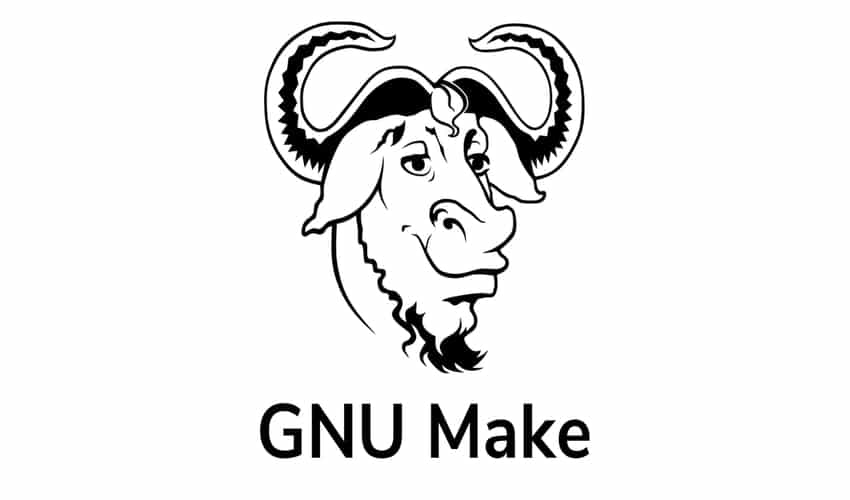
Features of make
- It allows the end-user to compile and install programs without having to understand the compilation logics.
- The make utility understands which parts of a program have been changed and thus do not compile the entire program upon modification.
- Since make is not limited to any specific programming language, developers can use it for executing additional tasks.
- Makefiles consist of rules that define how to derive the target application using multiple source files and libraries.
2. Apache Ant
Apache Ant is one of the best open-source build automation tools for Java. This popular project started back in 2000 as a replacement for the Unix make utility. It is very similar to make in terms of design and usage. However, Ant is meant for Java applications and require the Java runtime. It also uses an XML document to define the program creation workflow instead of the plaintext Makefiles. Ant makes it easy to adopt TDD (Test Driven Development) and is thus suitable for Agile development.
Features of Apache Ant
- Apache Ant offers a large number of in-built functions that make writing portable automation scripts much easier.
- It is easy to write the XML build instructions since they are hierarchial, ordered, and cross-linked.
- Apache Ant is available for all major Linux distributions and provides very well documentation support.
- The open-source codebase of Apache Ant allows developers to access and modify the source without any hassle.
3. Jenkins
Jenkins is one of the best build automation tools for enterprises due to its rich feature set and open-source codebase. It is essentially an automation server that makes it easy to build, test, and deploy modern software solutions. Jenkins employs a server-based master/slave architecture for managing distributed builds and offering Continuous Integration (CI) and Continuous Delivery (CD) services. Moreover, a thorough understanding of Jenkins will help you grab a high paying computer science job.
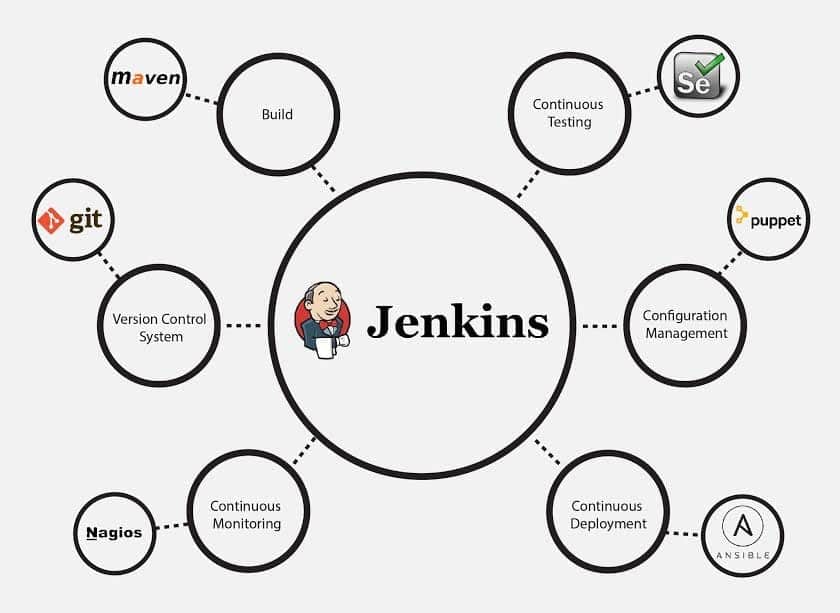
Features of Jenkins
- Jenkins is available as a self-contained Java program and provides binary installers for Windows, Linux, and Mac OS.
- Developers can easily extend Jenkins’ functionality by choosing from a large number of reusable plugins and extensions.
- Jenkins allows dev teams to distribute workload across multiple machines and achieve faster build times.
- The intuitive web interface of this automation tool helps to configure the server on the fly and check for errors.
- Jenkins has a solid community of developers that are working seamlessly to provide more exciting features.
4. Buck
Buck is an innovative build automation tool developed by Facebook and released as an open-source product. It encourages developers to use small, modular components and offers support for an extensive list of popular programming languages as well as computing platforms. Buck has become quite popular due to its modular design, which makes it easy to create reusable builds. Moreover, the open-source codebase is hosted on GitHub, allowing developers to extend the tool as per their needs.
Features of Buck
- Buck reduces incremental build times and leverages multiple CPU cores for speeding up build processes as much as possible.
- Since Buck only allows pre-defined inputs, the results will always be the same no matter which system you are using.
- Users can use the buck project command for integrating Buck with many popular Linux IDEs such as PyCharm and Eclipse.
- Buck makes it very easy for developers to understand build dependencies using the buck query command.
5. Gradle
Gradle is an elegant build tool that can be used for mobile apps and microservices alongside traditional desktop software. It is a very exciting project and is being used by a large number of tech companies, including Netflix and LinkedIn. Gradle is emerging as the best automation tool for projects that use JVM languages such as Java, Kotlin, and Scala. Moreover, its open-source codebase and Apache License encourages third-party modifications. We also like its simple design because it makes developers more productive.
Features of Gradle
- Gradle supports all projects written in conventional programming languages such as Java, C++, Python, and Kotlin.
- Its rich API and mature ecosystem allow developers to create complex build models and makes integration much easier.
- Projects that use Gradle enjoy blazing-fast build times due to its advanced caching and compilation methods.
- Gradle has excellent support for many popular Linux IDEs such as Android Studio, Eclipse, Jetbrains IDEA, and NetBeans.
- The enterprise plan reduces build times dramatically and helps to find errors for broken builds.
6. Travis CI
Travis CI is an efficient continuous integration service that makes it easy to build and test projects hosted on GitHub or BitBucket. One key benefit of Travis is that it offers both free and paid plans. So, developers can easily use it for testing their build performance and determining whether going pro would be a good choice or not. Moreover, Travis CI offers lifetime free testing for open source projects. Some of its other features include live build views, pre-installed database services, and cross-platform support.
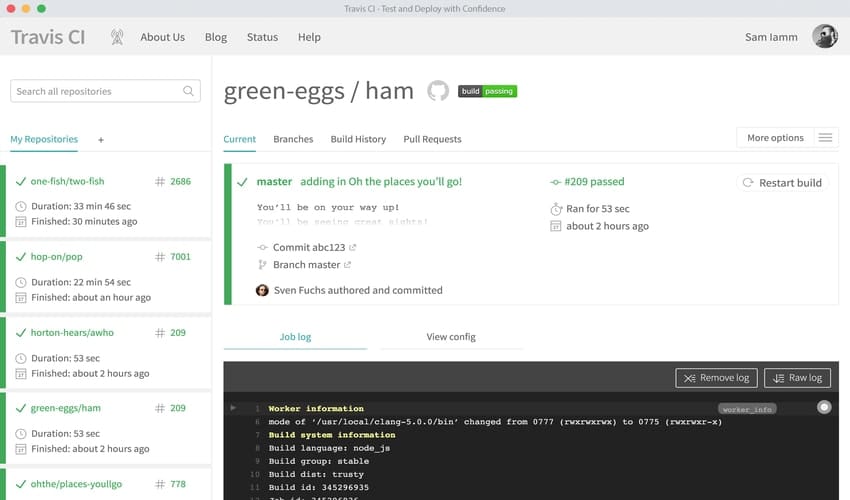
Features of Travis CI
- Travis CI has pre-built support for over 20 programming languages, including C, C++, Java, JavaScript, Python, and Ruby.
- It offers convenient subscription plans for enterprises as well as detailed documentation and tutorials.
- Travis offers clean virtual machines for each and every build and supports secure environment encryption.
- Developers can write robust automation scripts by leveraging the powerful API offered by this automation tool.
7. Apache Maven
Apache Maven is one of the most popular open-source build automation tools. Although Maven is mostly used for Java projects, you can also utilize it for other programming languages like Python, Ruby, and Scala. It is developed using the Project Object Model (POM) and can be used to build, report, and document modern software. Maven also integrates well with alternative build tools like Gradle. Moreover, since it is an Apache project, the codebase of Maven is open for all to inspect and modify.
Features of Apache Maven
- Apache Maven follows a simple project setup that allows developers to get started with a new project or module within seconds.
- Developers can easily extend the functionality of this build tool by using third-party extensions or writing their own plugins.
- Maven offers a large number of libraries and metadata for using out of the box and ensures real-time availability of the latest versions.
- It provides robust dependency management features, including a central repository of JARs, automatic updates, and dependency closures.
8. Bamboo
Bamboo is a progressive build automation tool that allows developers to create robust, multi-stage build plans. It is marketed by the popular software manufacturer Atlassian and offers features for continuous integration, deployment, and delivery. The aim of the Bamboo server is to provide easy and fast CI/CD services for DevOps professionals. It is suitable for all types of enterprises and offers competitive pricing plans. Moreover, you can test Bamboo easily by using its 30-day free trial.
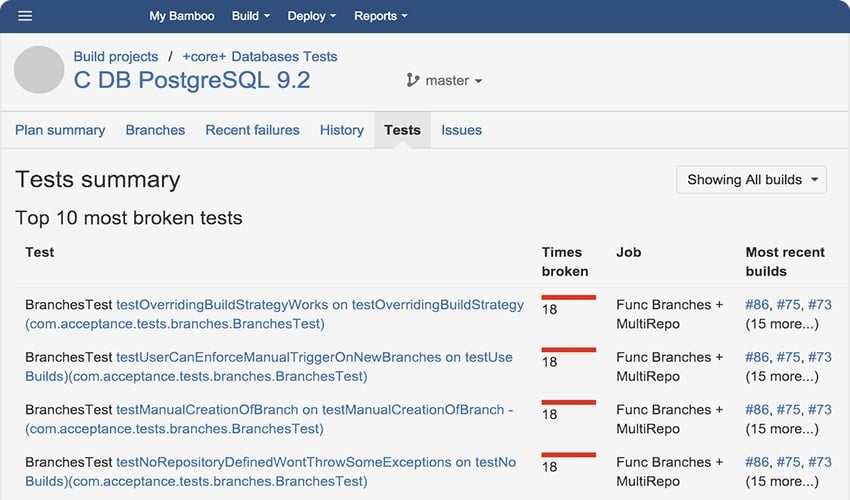
Features of Bamboo
- The bamboo server allows devs to run automated tests parallelly and assign custom agents to important builds and deployments.
- The software comes with all the necessary functionalities and does not require users to install new plugins or extensions.
- Bamboo offers a seamless development experience by combining tasks like builds, tests, and releases into a single workflow.
- It comes with pre-built support for most source code management solutions, including Git, BitBucket, SVN, CVS, Mercurial, and Perforce.
9. CircleCI
CircleCI is another continuous integration and delivery tool aimed at medium-sized enterprises. Developers can easily integrate this tool with GitHub or BitBucket, and it will create a new build for each commit. Some of CircleCI’s best features include expanded caching abilities, audit logging, and secure user management. You can host this build tool either in the cloud or on a personal server. The pricing options of CircleCI are also pretty competitive. It is used by many tech companies, including Spotify and Facebook.
Features of CircleCI
- CircleCI offers faster build times, reduced feedback cycles, as well as the freedom of choosing any framework or toolchain.
- It comes with a simple yet elegant interactive dashboard that shows summarized insights on all builds.
- CircleCI runs the pipeline in clean virtual machines or containers and allows developers to test every latest commit.
- It deploys the passing pipelines automatically to target environments and offers first-class support for Docker containers.
- Developers can configure the number of CPU resources(compute/memory) needed for specific pipelines.
10. Ansible
Ansible is certainly one of the widely used open-source build automation tools you can use. It is a software provisioning and deployment tool developed by Red Hat Incorporation. Ansible is entirely cross-platform and offers features like multi-tier deployments, cloud provisioning, agentless automation, and efficient orchestration techniques. Ansible is highly extendable and supports all major programming languages for writing modules. Moreover, it comes with a vast array of integrations that include AWS, CISCO, Windows, and VMWare, among many more.
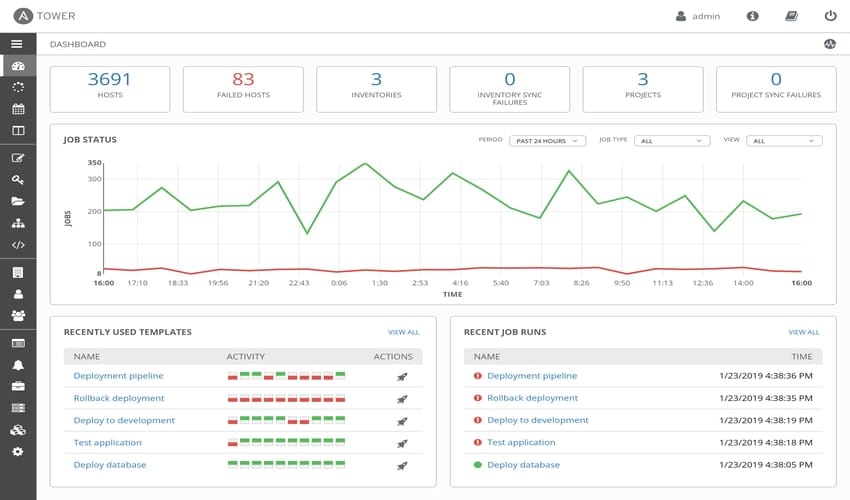
Features of Ansible
- Red Hat offers excellent pricing plans for enterprises that want to leverage Ansible for managing their tech services.
- Teams can directly integrate scanning and remediation of site security measures to their Ansible automation policies.
- Ansible alongside Red Hat Ansible Tower makes it very easy to streamline the process of spawning virtual or cloud instances.
- The Ansible playbook helps developers in deploying and managing applications properly throughout their entire cycle.
- Ansible modules can be written in any scripting language that can output JSON objects, including Python, Ruby, and Scala.
11. GoCD
GoCD is a smart CI/CD server that allows developers to automate and streamline the build, test, and release cycles without extra hassles. It is a free and open-source automation tool that makes it very easy to create effective pipelines. GoCD provides an easy to use dashboard for displaying the pipelines and associated analytics. The value stream map of this tool offers excellent end to end visualization. This allows devs to navigate across the jobs and optimize performance without requiring any external plugins.
Features of GoCD
- GoCD focuses on cloud-native development and streamlines continuous delivery workflows to AWS, Docker, and Kubernetes.
- Developers can create complex CD pipelines using robust modeling artifacts, parallel execution, and effective dependency handling methods.
- The advanced traceability functions of this continuous delivery tool make it very easy to troubleshoot broken pipelines.
- Users can choose from a growing list of external plugins or write their own plugins using GoCD’s rich API.
- GoCD offers handy testing features such as parallel execution, cross-platform execution, and sophisticated reporting.
12. TeamCity
TeamCity is a powerful build management and continuous integration tool developed by Jetbrains. It is one of the most popular proprietary build automation tools and supports all the major features required by modern pipelines. TeamCity emphasizes on reusable components and allows developers to check code quality easily. Developers can use the intuitive user interface for viewing build histories, managing users, integrations, and extensions. Plus, a curated list of useful plugins makes it very easy to add newer functionalities to this build tool.
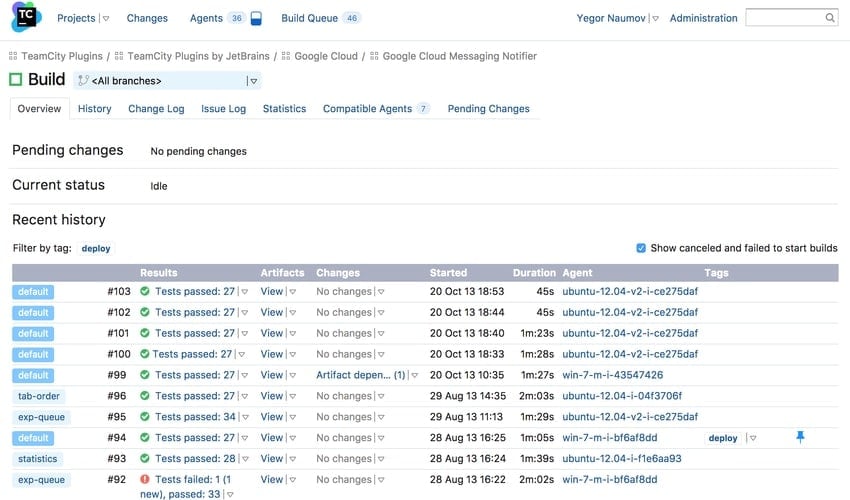
Features of TeamCity
- Developers can scale-out TeamCity build agents dynamically on Amazon EC2, VMware vSphere, Microsoft Azure, and Kubernetes clusters.
- TeamCity offers many useful integrations out of the box, such as Docker, Apache Maven, Visual Studio Team Services, and GitHub.
- This CI server can be easily customized by using service messages in the build scripts, TeamCity REST API, or official TeamCity plugins.
- TeamCity offers several features for system maintenance, including the ability to take backups, restore them, and showing disk usage analytics.
13. BuildMaster
BuildMaster is a simple but effective build automation tool that deals with application release processes. It is proprietary software that currently runs on Linux and Microsoft Windows. BuildMaster provides a simple plan editor that can be used for coding or as a drag and drop interface. This continuous integration tool also offers features like pipelines as code, issue tracking, PowerShell integration, event listeners, and synchronization of infrastructure configurations. Moreover, the pricing plans are very robust and include a free tier, several enterprise tiers, and custom subscription models.
Features of BuildMaster
- BuildMaster comes with all the features required for application building, testing, packaging, deployment, verification, and release.
- This paid automation tool allows devs to work with a variety of platforms, including .NET, Java, NodeJS, and PHP.
- Developers can easily refer to or import artifacts from other CI/CD tools, including Jenkins, TeamCity, and universal repositories.
- BuildMaster allows devs to create or manage build objects for any target, including Docker containers, cloud services, and Kubernetes.
14. Grunt
Grunt is one of the best open-source build automation tools for frontend developers. This tool makes it very easy to automate common tasks like code minification, unit testing, and linting. Grunt is built using NodeJS and is widely used by JavaScript developers. The build workflow of Grunt revolves around a Gruntfile, which is typically written in JavaScript or CoffeeScript. Moreover, Grunt has a huge collection of plugins that offers additional capabilities. This is why companies like Twitter and Adobe uses Grunt for their frontend.

Features of Grunt
- Grunt allows development teams to automate repetitive frontend tasks with minimum effort and has a simple workflow.
- This build tool can minify many file types, including JavaScript, CSS, SASS, LESS, and unit testing files.
- Grunt has a significantly large ecosystem that comprises of more than 4000 useful plugins and extensions.
- This tool offers several built-in tasks for reducing development time and increasing frontend productivity.
15. Rake
Rake is a simple make-like tool for the Ruby programming language. The aim of this build automation tool is to group tasks and build dependencies using Ruby syntax. It is configured using Rakefiles instead of Makefiles and does not require any XML files. Developers can easily define each task and its dependencies into namespaces. Another key benefit of Rake is that it is very easy to install and configure. Overall, Rake is a suitable choice for developers who are looking for a tool similar to make.
Features of Rake
- Rake provides excellent rule patterns for synthesizing implicit tasks and flexible FileLists for manipulating paths and filenames.
- It comes with a library of pre-packaged tasks that makes it very easy to write robust and performant Rakefiles.
- Rake has in-built support for parallel execution of tasks and eliminates many quirks associated with make.
- The open-source nature of this build tool allows developers to modify or extend the software without extra hassle.
- Its informative and detailed documentation makes it easy to learn new techniques and troubleshoot unwanted bugs.
16. gulp.js
gulp.js is a robust and effective JavaScript tool that is usually used for streaming frontend build systems. The aim of this build tool is to automate time-consuming tasks in development workflows. It has a growing ecosystem with over 2000 useful plugins and is totally platform agnostic. The minimal API of gulp.js makes it easy to master and reduces the learning curve for beginners. Overall, gulp.js is an excellent build tool for frontend developers working with JavaScript stacks.
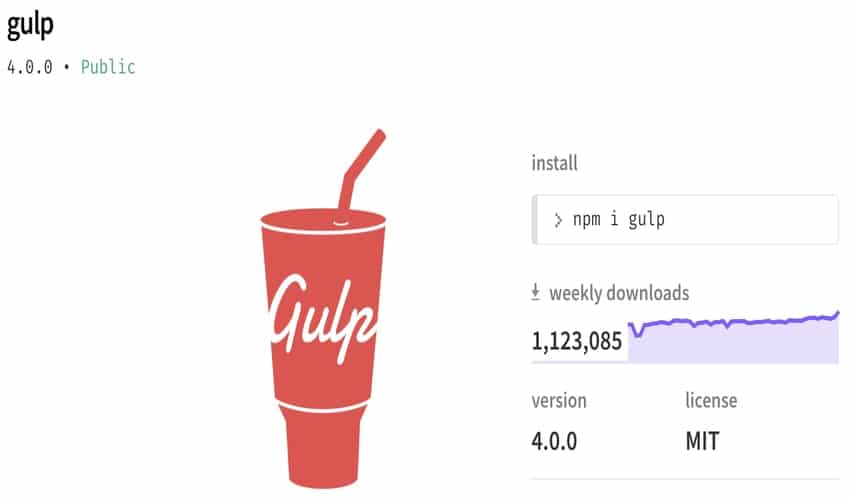
Features of gulp.js
- This JavaScript automation tool makes it easy to compose slow and repetitive tasks into robust build pipelines.
- Developers can choose from a large set of community-built plugins for reducing workload and increasing productivity.
- gulp.js reads files as streams and performs all the transformations required before writing back anything to the disk.
- The ability to create individual tasks and compose them into larger operations makes gulp fast and eliminates performance issues.
17. Codeship
Codeship is a simple take on continuous integration, deployment, and delivery services. Although proprietary, Codeship offers an excellent free tier that can create up to 100 builds per month. Plus, the pricing plans are very competitive. This makes it a suitable choice for starting and growing businesses. Configuring Codeship is very easy, thanks to its intuitive web interface. Developers can also set up the configuration options in files. Overall, Codeship is a lucrative alternative for teams that are looking for premium features at a cut-price.
Features of Codeship
- Codeship Pro comes with out of the box support for Docker containers and other cloud services.
- It implements a repository driven CI/CD workflow that makes it easy to track changes and control versions.
- Developers have full freedom in choosing the size and computing performance of the build machines.
- Codeship helps in saving development costs by running multiple different builds on the same Linux virtual machine.
- Dev teams can easily split up the tests and run them parallelly for speeding up their build times.
18. AWS CodeBuild
AWS CodeBuild is a fully managed CI service that compiles your code, runs necessary tests, and packages the deployable units. It eliminates the need to provision, scale, or manage your own servers and allows teams to concentrate on the application itself. Moreover, CodeBuild comes with a vast array of pre-packaged build environments, allowing the user to get started as soon as possible. Being a product of Amazon, CodeBuild ticks all the right spots when it comes to functionalities.
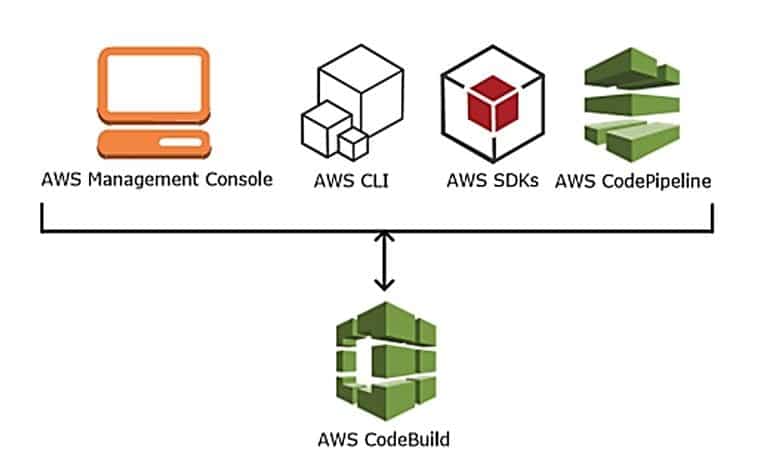
Features of AWS CodeBuild
- Since CodeBuild is fully managed, developers do not need to set up, manage, update, or patch their build servers and CI services.
- The ‘pay as you go’ pricing plan reduces cost significantly, charging for only the number of minutes required by the builds.
- CodeBuild makes scaling extremely easy, scaling up and down automatically for meeting the demands of your build.
- Teams can extend the build service by importing their own build tools and environments alongside the pre-packaged tools.
- CodeBuild is integrated with AWS Identity and Access Management (IAM) and encrypts artifacts using the AWS Key Management Service.
19. Chef
Chef is an innovative automation suite for enterprise infrastructures. It can transform infrastructure into code and is a suitable choice for companies that sell IaaS (Infrastructure as a Service) products. Chef is basically a combination of two suites, one is the Enterprise Automation Stack, and the other is the Effortless Infrastructure suite. Some of the largest companies in the world are using Chef, such as Facebook, IBM, and Walmart. All in all, it is an excellent platform automation tool for growing tech businesses.
Features of Chef
- Chef’s continuous delivery pipeline is very sophisticated and makes sure the applications are performing as they are supposed to.
- It integrates extremely well with popular build automation tools, virtual environments as well as cloud services.
- This automation tool makes it easy to migrate legacy software and modernize them for increasing agility and speed.
- Chef aims to reduce the security trade-offs between risk and agility, which are introduced by current DevOps practices.
- It is one of the best automation tools for increasing product shipment speed while maintaining compliance guidelines.
20. Azure DevOps Server
The Azure DevOps Server is Microsoft’s answer to AWS CodeBuild. It is an extremely powerful solution that covers all aspects of an application lifecycle. Azure DevOps Server has the ability to manage projects, automate builds, run testing, report, and release builds. This is a paid service with pretty competitive pricing options. It also offers free tiers for companies who want to take a look at its offerings. Overall, Azure DevOps Server is an excellent choice for businesses that are looking for managed services.
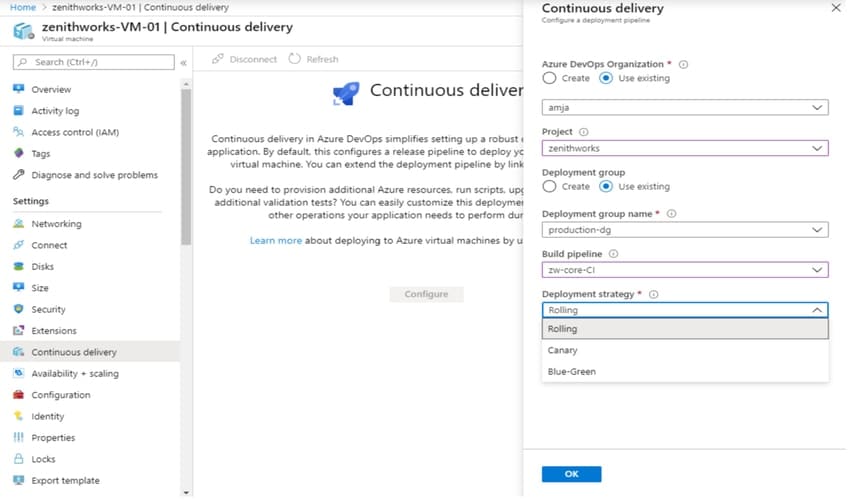
Features of Azure DevOps Server
- Developers can easily create, host, and share packages with their team members and add artifacts to their pipelines.
- Azure extensions marketplace hosts a large number of extensions for apps and services built by open source developers.
- It is very easy to plan efficient, agile development steps by using customizable Kanban boards, backlogs, and other robust planning tools.
- Teams can build and test applications using any programming language and deploy them to any cloud service.
Ending Thoughts
Build automation tools encompass a wide variety of tools that aims to reduce the gap between software development and end product deployment. The technology atmosphere is evolving continuously, and companies must adapt to meet growing business demands. Luckily, a large number of automation tools are available for solving different problems. Moreover, there are also many open-source build automation tools that do not require companies to pay huge amounts. These can be a good starting point for growing enterprises.
Our editors have selected the above 20 tools for helping our readers determine the best automation platform for them. Don’t forget to leave a comment if you have further recommendations.
